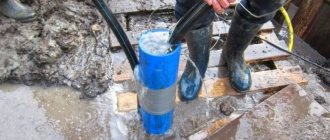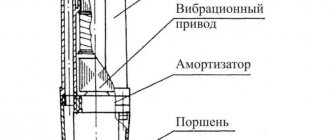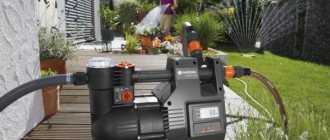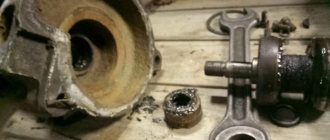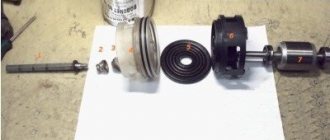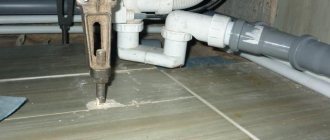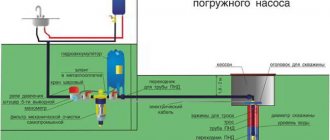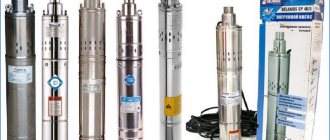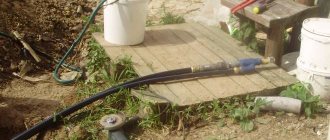Submersible water pumps have long been used in many areas of human activity for pumping liquids for domestic and industrial purposes. Most household plots are equipped with equipment for supplying water from wells; it is also used when pumping liquid from wells, tanks, flooded basements and drainage pits. The most common brands are Gilex, Malysh, and Grundfos pumps. With constant use of the units, their service life is exhausted quite quickly; owners have to regularly repair submersible devices of varying degrees of complexity.
Determining the cause of the malfunction
If the pump does not pump water, then most likely one of the most important components of its functionality is broken - this is:
- Sufficient quantity and level of water in the hydraulic structure.
- Power supply of pumping equipment in accordance with its specified characteristics - voltage, frequency, current.
- The design power and productivity of the unit corresponds to the parameters of the well - depth, volume.
- The filter system, pipeline, valves, fittings are in good condition.
As a rule, an autonomous source of water supply works not only to supply the house, but also the vegetable garden, garden, greenhouses, bathhouses, swimming pools, etc. In this case, the source of the breakdown may be located not only in the premises or consumption facility, but also in the pipeline or equipment and the well itself. The best quick way to find a breakdown is to use the elimination method:
- First, the caisson supply pipe is disconnected. If water comes out of it, it means there is a breakdown in the line or at the consumer.
- If water does not flow when the caisson hose is disconnected, the problem lies in the well itself or the pumping equipment.
Construction of a water well Source oskada.ru
Note! Sometimes, outwardly, the pump may appear to be working properly and make operating noise when there is no water being pumped at all. There may be several reasons for this - errors were made in the installation of equipment or in the selection of its components, the natural water level has decreased, constant voltage drops in the network, a phase failure has occurred in the electric drive housing.
See also: Catalog of companies that specialize in engineering systems (heating, water supply, sewerage and others) and related work
Nuances of repair
In the cases listed above, an experienced equipment owner can repair the submersible pump with his own hands - clean clogged parts or install new ones. Repair instructions can be found on numerous videos on the Internet. But experts still recommend contacting special service centers, since the repair of submersible pumps of different brands has its own nuances, which the owner of the equipment may not be familiar with.
For example, with Gilex brand equipment, repairs most often involve adding oil to the engine. Devices of this brand are equipped with oil-filled engines, in which oil leakage can cause malfunctions and damage to other components. To add oil to the Gilex pump, professionals strongly recommend using the original product. Many equipment owners believe that they can add a substitute such as glycerin or transformer oil, but in the end such dubious savings only lead to accelerated wear and tear of the device.
The most common problem with Malysh brand products is loud noise that occurs even without pumping out water. The cause of the problem is a rupture in the central axis of the unit. The noise occurs because the broken axle no longer holds the armature and the membrane. The problem is resolved by replacing the part.
In addition to the fact that service center specialists are familiar with repairing water pumps from any manufacturer, when you contact them for a service, they provide free diagnostics of the devices. Therefore, before starting to repair a submersible centrifugal pump with your own hands, the owner of the equipment must consider all the options and take into account the pros and cons of each of them.
The main reason
If the pump hums but does not pump water, the reasons lie either in a clogged source or in technical problems with the equipment. Indirect signs indicating clogging with small particles are:
- Cloudiness of the water stream.
- Increasing reduction in pressure with fully functional operation of the unit.
- The presence of small particles, sand, silt and other impurities in the water.
Clogging of equipment with sand, silt or rock occurs as a result of the following series of processes in the well itself:
- The initial presence of small algae in the water.
- Collapse of the canal walls.
- The presence of rock or sand particles in a ground flow.
- Sludge stirring up from the bottom during pump operation.
The well produces muddy water Source oskada.ru
As sediment accumulates, the cross-section of the watercourse will narrow, the water entering the surface will become cloudy, and the pressure will weaken until the supply completely stops. However, the sensor installed to turn off the motor in this situation may not work, and therefore the equipment will continue to operate.
To resolve the problem, the following series of operations are performed:
- All equipment is de-energized.
- The pump is lifted and removed from the well.
- The remaining water in the canal is pumped out.
- The inside of the well is cleaned and disinfected.
- The fluid is pumped out again from the canal.
If all procedures were performed technically correctly and the equipment was not damaged, after the instruments are returned to their places and started, the well will start working with the same strength.
Preventive measures
To prevent or minimize the likelihood of serious breakdowns of downhole equipment, it is necessary to carry out high-quality preventive maintenance at annual intervals. This will allow timely identification of problems in the operation of nodes. The ideal time for manipulation is spring and autumn.
- Carefully remove the deep well pump from the damp environment. On the surface, carefully examine the housing for minor defects/scuffs, and also examine the condition of the electrical cable and hanging safety rope. If you do not pay attention to worn parts in a timely manner, this may lead to equipment breakage or fire due to a faulty electrical cable.
- Examine the pump for deformation, dirt or corrosion. The components must be thoroughly cleaned and rinsed with plenty of clean water.
If a large amount of silt or sand accumulates on the surface of the housing, this indicates sanding of the well. Therefore, it requires washing. Having lowered the pump into a container of clean water, you need to turn it on and check for extraneous noise. If any are observed, one of the nodes is not working correctly.
Problems with well pumps are not uncommon. This is usually due to non-compliance with operating and maintenance rules. You need to take care of the operation of the pumping station at the stage of purchase. It is important to choose the right model with optimal power, since a high-power model will run idle, wearing out parts, and a low-power model, due to technical limitations, will not be able to satisfy the buyer’s needs. Housing and communal services or Vodokanal employees will be able to help in this matter.
Algorithm for further actions
Sometimes, even after completely cleaning the borehole channel, the watercourse is not restored. In this case, there are several reasons why the pump does not pump water:
- The mechanics of the equipment were damaged.
- There have been disturbances in the electrical circuit.
- There was a depressurization of the central pipeline.
- The control system has broken down.
Checking the pumping station Source sovet-ingenera.com
To identify the malfunction, the pump is again removed from the well channel and immersed in a barrel filled to the brim. Next, the engine is started and diagnostics are carried out. There are three possible scenarios:
- The motor has started and is working properly - therefore, there are no breakdowns in the electrical circuit.
- The engine does not turn on - disassembly and electrical repair is required.
- The pump is operating, but the outlet pressure does not reach operating levels.
Low pressure when the unit is running may indicate breakdowns in the line. If it is not possible to visually establish their location, then plugging the flow outlet, for example, with the hand of a hose, will provoke a sharp increase in pressure in the pipe and the formation of water streams in places of leakage.
Advice! Repairing a broken hose operating under pressure is unreliable. Because under the influence of pressure, both the patches and the glued areas will constantly break through and lead to even greater leakage. It is better to immediately replace it with a new one.
Replacing the main hose Source ytimg.com
Location, design and role
The coolant pump is the heart of the cooling system. In addition, the system includes components such as the radiator, radiator fan with thermal switch (driven by an electric motor or viscous coupling, transmitting drive from the engine), thermostat, coolant tank, rigid and flexible coolant hoses, and in newer vehicles also electronic sensors.
How does the cooling system work? It uses a consumable fluid - a coolant made from demineralized water, mixed in the correct proportions with glycol, alcohol, anti-corrosion additives, defoamers, etc. The liquid is selected according to the material from which the car radiator is made.
The cooling system starts working immediately after the car is started. The water pump (coolant pump) is driven by a timing belt, timing chain, or V-belt. Thanks to its operation, coolant begins to circulate throughout the vehicle's cooling system. Initially, immediately after starting the engine, it bypasses the radiator. Thanks to special channels inside the engine, the coolant flushes the cylinder walls and reaches the engine head. The fluid pressure depends on the engine load, usually the fluid is at a pressure of 1 to 1.5 bar.
When the engine reaches operating temperature, the coolant temperature also increases. After reaching the appropriate values, due to the temperature, the thermostat opens. As a result, the coolant begins to circulate through a large circuit with the cooler. From now on, the cooling system acts as a guarantor against engine overheating. The cooling system also heats the interior as fluid flows through the heater. Additionally, on vehicles with an EGR valve, the system flows through the EGR cooler.
Because coolant can pass through the coolant pump without having to start it, solutions such as parking heaters and electric engine heaters with their own electric pumps can be used to drive the coolant.
Where is the cooling pump installed? On the engine itself so that it can be driven by a timing belt, timing chain or serpentine belt, depending on the solution used in the vehicle.
How does a water pump work? The pump does not have a complex design. It consists of four main elements:
- the drive wheel, to which torque is transmitted from the crankshaft pulley through a timing belt, timing chain or serpentine belt, depending on the design;
- an impeller made of metal or plastic that drives the coolant;
- a mounted shaft, at opposite ends of which a drive wheel and an impeller are mounted;
- metal case;
In addition, seals are also used.
The pump works without pumping
The reasons why the pump does not pump water from the well, even if the electrics are working properly and the main line is intact, may be the following:
- Filter and check valve clogged. The knots may become clogged with sand, silt, rock particles, or algae. To restore operation, the devices are cleaned or replaced with new ones.
- Dry running sensor malfunction. The burnt out sensor is replaced. Otherwise, the motor may overheat when the water level drops, with corresponding consequences.
Good to know! Submersible vibration pumps often fail when overloaded. The reason is failure of the piston or destruction of the rod. Damage can be avoided by constantly monitoring operating parameters.
Independent work or professional help?
The following malfunctions of the submersible pump allow you to cope with the problems yourself, without the involvement of a specialist. However, even in these cases, you must understand well that without knowledge of the technology, the problem that has arisen and minimal skills, it is quite difficult to cope with the repair.
Before searching for any fault, you need to get acquainted with the design. First of all, you need to carefully study the instructions for the unit and its diagram. In order not to end up with unnecessary parts later, you need to remember the sequence of actions during disassembly. When working with any unknown device, it is recommended to photograph each step.
The price of a submersible pump plays a big role. Small “liberties” are allowed when repairing simple, inexpensive models, since in this case it will be more or less simple to assemble and disassemble the structure. Expensive imported (European) models have a longer warranty period, so the best solution in this case is to contact a service center.
Common breakdowns
There are several other common reasons why the pump works but does not pump water - these are:
- A decrease in the natural water level due to seasonal changes or improper well construction.
- Increased pump performance.
- Insufficient power of the unit in terms of head height.
- Voltage drop in the network.
- Clogging of pipelines, filter units and fittings.
- Depressurization of the main line.
- Breakdown of pumping mechanisms.
If the pump works but does not pump water, the reasons may also be hidden in the breakdown of its critical mechanical parts. The situation can be corrected either by repair or installation of a new unit.
Important! To ensure uninterrupted operation of an autonomous source, pumping equipment must be correctly selected according to the height of the flow being lifted. In this case, the calculation takes into account not only vertical, but also horizontal sections. As a rule, a lying section of pipe of 5 meters is equivalent to a 1-meter segment located standing.
Extraneous noise during operation
Immediately after purchasing the pump, it is very important to carry out several short-term dry runs and one or two long runs with immersion in a container of water. At the same time, the nature of the noise during operation is assessed and remembered.
A change in sound tone may indicate a mismatch in the supply voltage. If it drops strongly, the engine rumble will be lower and more strained; if such a pump is lowered into a well, it may simply not raise water to the required height, even if it is fully operational. Too high a tone may be due to the fact that the pump does not transmit rotation to the impellers or other working element. The cause may be a burst shaft, worn-out splines on the rod connection, or broken impeller seats.
The presence of howling (singing) during operation is a characteristic sign of increased friction in the support bearings. Broken separators may be indicated by a crackling sound or severe vibration. An extreme case is when the shafts become jammed, with the pump motor humming strainedly but not rotating.
Briefly about the main thing
There may be two main reasons why a water pump does not pump water - clogging with sand or mechanical failure of the equipment. In addition, malfunctions can occur in the following cases:
- Insufficient water level in the well.
- The operating parameters of the equipment are incorrectly selected.
- Failure of the mechanical parts of the unit.
- Clogging of the borehole channel, filters, pipelines, fittings with sand, silt, rock.
- Depressurization of the main line.
- A drop in the characteristics of the electric current in the network.
- Dry running sensor failure.
The easiest way to check and restore the operation of the well is to remove the pump and clean the water source channel. If this does not help, the equipment, electrical circuits and the integrity of the highway are successively checked for serviceability.
Ratings 0
Practical recommendations
Before disassembling the upper part of the electric motor, it is necessary to install it in a vertical position. This measure is necessary, since otherwise the oil, which is the working fluid in most modern systems, may leak out, and this is unacceptable.
After this, be sure to remove the cover into which the power wires of the electric motor go. Here you can immediately find a starting capacitor. You will have to use an ohmmeter to check the resistance of the starting and operating windings.
To do this, take the ohmmeter terminals and connect them to the winding. The handle is rotated, which creates a voltage of several hundred volts. If the device shows a resistance that has a certain value, but not infinity, then all windings are in good condition. If the device shows infinity on the working winding, then there is a break in the working phase of the motor.
If the resistance, on the contrary, is too small, then an interturn short circuit has occurred. When one of the above breakdowns occurs, self-repair is out of the question. The unit will have to be taken to specialists.
If the instrument readings show that everything is in good condition, you should check the starting capacitor. It is quite possible that it was he who failed. It may also be in a cliff. At first glance, this may not be detected, but the device will definitely detect such a malfunction. Then you can do the repairs yourself. Most often, the capacitor is replaced. However, sometimes it can be repaired, but in very rare cases. Most likely, it burned out, and this malfunction is fatal for this electronic element.
Return to contents
If you liked the article, please share it
Previously on the topic:
Share
The cost of installing heating systems
Heating system installation
| Heating radiator installation | PC | from 2,000 ₽ |
| Installation of a floor-mounted convector | PC | from 4,500 ₽ |
| Installation of a heating radiator ( non-standard size, cast iron, design) | PC | from 4,500 ₽ |
| Installation of distribution heating cabinet | PC | 4 500 ₽ |
| A set of works for installing a heating system for a house up to 100 m² | from | 49 500 |
| A set of works for installing a heating system for a house up to 150 m² | from | 52 500 |
| A set of works for installing a heating system for a house up to 200 m² | from | 72 500 |
| A set of works for installing a heating system for a house up to 250 m² | from | 87 500 |
| Please call for exact cost | 84957446774 |
The cost of installing heating systems . Price adjusted as of May 05, 2021 Attention. This cost is a preliminary estimate; these prices should only be used as approximate prices. The exact cost of the work is calculated after an engineer visits the work site, its complexity, and quantity.
Installation of an underfloor heating system (warm floor)
| Water heated floor | m² | from 500 ₽ |
| Distribution manifold cabinet for underfloor heating (external) | PC | 4 500 ₽ |
| Heated floor temperature control device | PC | from 2 000 ₽ |
| Heated floor temperature control groups (thermostatic valve, thermostat with clamp-on sensor, bypass valve, starter) | PC | 3 750 ₽ |
| Main pipes heating system and pipe insulation (cross-linked polyethylene, metal-plastic) up to 20 mm | m/linear | 100 ₽ |
| Main pipes heating system and insulation with pipe insulation (cross-linked polyethylene, metal-plastic) up to 32 mm | m/linear | 230 ₽ |
| The exact cost is calculated after check-out | engineer |
The cost of installing heating systems . Price adjusted as of May 05, 2021 Attention. This cost is a preliminary estimate; these prices should only be used as approximate prices. The exact cost of the work is calculated after an engineer visits the work site, its complexity, and quantity.
Installation of heating systems for warehouses, hangars, workshops, car service centers
| Installation of a fan heater , with pipes, fastening to a concrete wall | PC | from 15 000 ₽ |
| Installation of automatic fan heater control | PC | from 4 500 ₽ |
| Pressure testing, commissioning, filling with coolant | m2 | from 100 ₽ |
| Register mounting, thread | PC | from 6 750 ₽ |
| Register installation, welding | PC | from 15 000 ₽ |
| The exact cost is calculated after check-out | _engineer_ |
The cost of installing heating systems . Price adjusted as of May 05, 2021 Attention. This cost is a preliminary estimate; these prices should only be used as approximate prices. The exact cost of the work is calculated after an engineer visits the work site, its complexity, and quantity.
Installation of water supply heating systems Klin, Klinsky district
Heating cost calculation
The cost of repairing heating systems
Cost of installation of water supply
Similar services:
- Replacing the circulation pump Without a pump, it would be difficult to achieve uniform heat distribution throughout the house. It is he who is responsible for the fact that the coolant…
- Malfunctions of water heated floors The most common malfunctions of water heated floors are associated with: Damage to the pipe after the floor screed has been filled; Insufficient amount of insulation,…
- Heating a house without a pump Having decided to build a private house, every owner must carefully consider heating, since without it you will not be able to live through the winter...
- Replacing a pump in a boiler room Replacing a pump in a boiler room in a country house from Design Prestige LLC. High-quality boiler room repairs using modern technologies at affordable prices...
- Replacing a heating pump Replacing a heating pump for a private home, repairing heating systems, diagnostics, replacing pipes, boiler, fittings. Upgrading heating systems...
- Replacing the pump Electric heating - Replacing the pump Despite the popularity of gas heating, its electric prototype is gaining an increasing number of fans. So that the electric boiler receives...
- Heating without a pump Heating without a pump Installation of water heating must be done with high quality, like the system as a whole, for its correct operation, so that…
- Heating a house 100m As you know, the most important thing in your own private home is warmth, comfort, convenience and coziness. It is necessary for all family members...
- Home heating cost The cost of heating depends on many components, primarily on the type of boilers, their power (the more powerful, the more expensive), as well as their manufacturers...
- Heating a private house - boiler room Heating a private house for Russia is one of the most important topics when starting construction. But despite all its importance, many...
- Gas heating of a country house In a warm house, you can always shelter from cold and bad weather, even if it is a country house. After all, now it’s easy...
- Heating and boiler room Heating of the house must be thought through before the construction of the house itself begins. Especially if this house is not just an easy home for a summer resident,…
- Electric home heating Electric home heating is much more amenable to automation than any other heating method. In an electric boiler, water is heated using a heating element, similar to...
- Economical heating of a country house You can understand this as an inexpensive installation of heating in a cottage, or as a system that does not require expensive maintenance... in my opinion, economical...
- Water heating at home - Boiler room Most of us are accustomed to comfort and one of the conditions for ensuring it is warmth in our home. In harsh...
- Cost of installation work HEATING WATER SUPPLY Heating repair Installation of heating in a dacha Installation of winter water supply in a private house Installation of winter water supply in a dacha, installation of heating in a private…
- Advantages and disadvantages of heating with an electric boiler Heating with an electric boiler is a widespread method of heating a private country or country house. In general, we can say that behind electricity,…
- Installation of a heating system in a country house Previously, most country houses were tightly closed for the winter at the end of the season. And the Soviet proverb says that one move is equal to...
- Boiler room repair Klinsky district The Design Prestige company carries out boiler room repairs in the Moscow region. Offers service……
- Autonomous heating of a private house Autonomous heating for a private house, installation of heating in a country house…
Boiler room maintenance cost
Technical (service) maintenance of the boiler room
| Name of works | Volume | Price |
| Service contract for floor-standing boiler (gas, diesel) up to 60 kW | with 1st scheduled departure | from 14 000 ₽ |
| Service contract for floor-standing boiler (gas, diesel) from 60 to 170 kW | with 1st scheduled departure | from 20 000 ₽ |
| Service contract for floor-standing boiler (gas, diesel) up to 60 kW | with 2 scheduled trips | from 22 000 ₽ |
| Service contract for floor-standing boiler (gas, diesel) from 60 to 170 kW | with 2 scheduled trips | from 30 000 ₽ |
| Service contract for wall-mounted gas boiler | with 1st scheduled departure | from 10 000 ₽ |
| Service contract for wall-mounted gas boiler | with 2 scheduled trips | from 15 000 ₽ |
| The exact cost is calculated after check-out | engineer |
Attention. This cost is a preliminary estimate; these prices should only be used as approximate prices. The exact cost of the work is calculated after an engineer visits the work site, its complexity, and quantity.
Boiler room repair, diagnostics and prevention
| Name of works | Volume | Price |
| On-site inspection and diagnostics (without repair) | up to 50 km from MKAD | from 3,500 ₽ |
| On-site inspection and diagnostics (without repair) | from 50 to 100 km from MKAD | from 5,500 ₽ |
| Cleaning the burner (atmospheric) | power up to 60 kW | from 2,000 ₽ |
| Cleaning the burner (supercharged) | power up to 60 kW | from 3,500 ₽ |
| Cleaning the burner (atmospheric) | power from 60 to 170 kW | from 8,500 ₽ |
| Cleaning the boiler combustion chamber | power up to 60 kW | from 4,000 ₽ |
| Cleaning the boiler combustion chamber | power from 60 to 170 kW | from 6,000 ₽ |
| Checking and pumping up pressure in the expansion tank | without dismantling work | from 2,500 ₽ |
| Checking and pumping up pressure on the expansion tank | with dismantling and installation | from 4 500 ₽ |
| Refilling the heating system with a pump | system volume up to 200 liters | from 3 000 ₽ |
| Replacement of heating element, pump, heat exchanger, with coolant drain | for a unit | from 3 000 ₽ |
| Conversion of a gas boiler to liquefied gas | for a unit | from 3 000 ₽ |
| Burner settings | gas / diesel | from 2 500 ₽ |
| The exact cost is calculated after check-out | engineer |
Attention. This cost is a preliminary estimate; these prices should only be used as approximate prices. The exact cost of the work is calculated after an engineer visits the work site, its complexity, and quantity.
Heating a house 100 m²
Really, honestly, really
| Heating a house 100 m² from | RUR 49,500 |
| Installation of heating boiler | 8,000 rub. |
| Installation of heating radiators (no more than 10 pieces)!!! The cost of installing a standard (mounted, not in-floor convector) heating radiator is 4,000 rubles | 25,000 rub. |
| Radiator pipe routing | 12,000 rub. |
| Pressure testing and filling with coolant | 4,500 rub. |
| TOTAL turnkey: | RUB 49,500 |
| Drilling holes, rigging, dismantling, paid extra | according to_estimate |
Heating a house 100 m² Attention. This cost is a preliminary estimate; these prices should only be used as approximate prices. The exact cost of the work is calculated after an engineer visits the work site, its complexity, and quantity.
Cost of materials from 120,000 rubles
Included by type of work
| Boiler installation | Installing an electric boiler on a wall or floor |
| Installation of pipes without “grooving” | Open pipeline installation with wall or floor mounting |
| heating radiators | Mounting the heating device on the wall, installing fasteners |
| System pressure testing | Pressure testing of the assembled system with an air compressor to identify possible leaks |
| Commissioning works | Filling with coolant (antifreeze or water), removing air from the heating system during work |
| !!! No heated floors | It is calculated additionally, it requires coordination of the type of substrate for the pipes, the type of use of the pipe, the possibility of control and automatic control, and of course the footage |
| !!! Without external chimney | To calculate the cost, an engineer’s visit is required, an inspection of the roof structure, window location and much more. |
House heating
